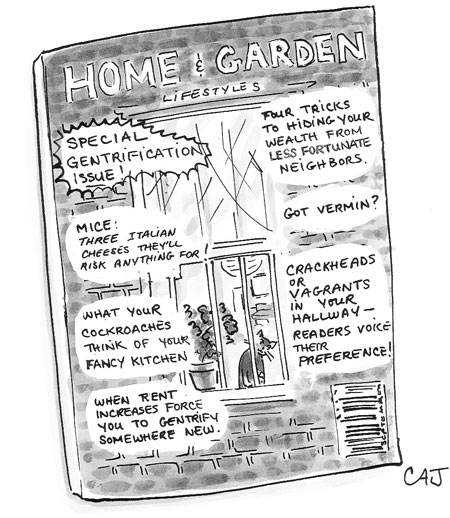During Lecture 12 “The Culture of Poverty,” Professor Nelson brought up Douglass Massey and Nancy Denton’s book American Apartheid. Having read the entire book prior to the class, I recalled their presentation of white flight, which is the phenomenon of white individuals essentially electing to move after a particular percentage of African Americans moving into their neighborhood. An arguable indication of racial intolerance as well as instigator of problems that the book elucidates, white flight is an intriguing issue but so is the phenomenon that seems to be its opposite- gentrification. Although still perpetuating segregation by race and class, gentrification essentially pushes lower class communities, often of African American descent, out of certain areas.
I first really saw clear signs of gentrification when working in Harlem. A place known for the Harlem Renaissance around the 1920s and 1930s, it is an important entity for African Americans as well as a desirable location to buy real estate for more affluent populations. While working out of Harlem Hospital, I had the opportunity not only to check a number of local venues but also to walk past the construction sites of a number of condos. I read about the closing of restaurants who no longer appealed to the shifting demographic as well as heard complaints from people living and working in the area.
Gentrification is an interesting issue explicitly tied to class issues. I personally am conflicted about it to a large extent because I believe that residential segregation perpetuates the concentration of poverty that Massey and Denton discuss in American Apartheid and thus points brought up in it and in Lecture 12 “The Culture of Poverty.” At the same time, the fact that the settling of people affects real estate prices and/or the goods and services available not to mention the overall culture of a location means that there is a tenuous tipping point around which perpetuate the aggregation of either low or high class individuals. To me gentrification seems harsher because people are essentially been driven out of their homes by economic circumstances whereas white flight people are driven out because of personal preferences (or arguably prejudices) and/or factors that should be addressed rather than avoided, such as crime. But that is just my opinion, which may be biased because I really like the historical, traditional charm of places like Harlem, Brooklyn, and U Street in DC that are becoming gentrified…
__________________
Martha’s Tangential Cartoon Pick!

